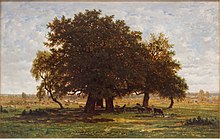10月4日
米勒(Jean-François Millet)
(西元1814.10.4—1875.1.20)
法國畫家。屬於自然主義的巴比松畫派。中年時為了維持生計必須下田耕作,因而得以描繪出純樸的田園風光,享譽世界畫壇。著名畫作包括《拾穗》、《晚禱》與《播種者》等。
如果想要感動別人,就必須先感動自己。假如不這麼做,無論是多麼精巧的作品,也絕對沒有生命。
藝術不是消憂解悶的遊戲。而是一場戰役、一具絞碎物體的齒輪機械。
美的重點在於呈現。若要畫出自己的母親,就該抓住母親凝視孩子的時刻,施展全力畫出最美麗、最純粹的那個瞬間。
節自 朱里亞.卡萊德《米勒藝術史》
Millet 怪法國諸文豪沒有留下它們對藝術的心得,來指導法國人民.....兩問題:
能夠這樣教化嗎?文學與藝術,兩回事.....
左拉不算
官方的獎與榮譽對於19世紀法國畫家.....Manet、Théodore Rousseau vs Corot
Renoir 一書中的 Barbizon
風景畫的兩傳統:
義大利-法國
英國-法國
Millet與Théodore Rousseau的友情
Jean-François Millet (French: [milɛ]; October 4, 1814 – January 20, 1875)
Étienne Pierre Théodore Rousseau (April 15, 1812 – December 22, 1867) was a French painter of the Barbizon school.
Later years[edit]
Rousseau then suffered a series of misfortunes. His wife's mental health had worsened; his aged father became dependent on him for pecuniary assistance; his patrons were few. Moreover, while he was temporarily absent with his ill wife, a youth living in his home (a friend of his family) committed suicide in his Barbizon cottage. When he visited the Alps in 1863, making sketches of Mont Blanc, he became dangerously ill with inflammation of the lungs; and when he returned to Barbizon he suffered from insomnia and became gradually weakened.[1]
He was elected president of the fine-art jury for the 1867 Exposition; however, his disappointment at being denied the better awards may have affected his health, for in August he became paralyzed. He recovered slightly, but was again attacked several times during the autumn. In November his condition worsened, and he died in the presence of his lifelong friend, Jean-François Millet, on December 22, 1867. Millet, the peasant painter, for whom Rousseau had the greatest regard, had been much with him during the last years of his life, and at his death Millet assumed charge of Rousseau's ill wife.[1]
Rousseau's other friend and neighbor, Jules Dupré, himself an eminent landscape painter of Barbizon, relates the difficulty Rousseau experienced in knowing when his picture was finished, and how he, Dupré, would sometimes take away from the studio some canvas on which Rousseau was laboring too long. Rousseau was a good friend to Diaz, teaching him how to paint trees, for until a certain point in his career Diaz considered he could only paint figures.
Étienne Pierre Théodore Rousseau (April 15, 1812 – December 22, 1867) was a French painter of the Barbizon school.
兩本《錢鍾書先生百年誕辰紀念文集》(2011) (有三聯本和牛津大學出版社本) 中,只讀王水照 《錢先生的兩篇審稿意見》《讀錢鍾書先生的《宋詩選注》》、《鍾叔河 錢先生的不忍之心》.......
桑原武夫 《一日一言 11月4日 》吳季倫譯
慧能大師
(約貞觀12—先天2∕西元638—713年)
中國唐代的僧人與思想家。佛教禪宗門派的第六位正統繼承者,世稱六祖慧能。為後世禪宗諸派的宗師。相傳聽道即悟,但不識字。著名佛偈:「菩提本無樹,明鏡亦非臺。本來無一物,何處惹塵埃。」
師示眾云:「善知識!我此法門,以定慧為本。大眾勿迷,言定慧別,定慧一體,不是二。定是慧體,慧是定用,……名雖有二,體本同一。此定慧法,亦復如是。」
節自《六祖法寶壇經‧定慧第四》
師言:「汝等諦聽,後代迷人,若識眾生,即是佛性;若不識眾生,萬劫覓佛難逢。吾今教汝識自心眾生,見自心佛性。欲求見佛,但識眾生,只為眾生迷佛,非是佛迷眾生。……」
節自《六祖法寶壇經‧付囑第十》



沒有留言:
張貼留言